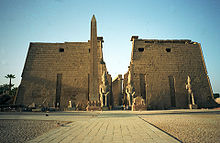CLOCKS IN ANCIENT TIMES
Obelisk of Ramesses Ii and Pylons,
Temple of Luxor, Thebes, Egypt
Stonehenge, England
They also developed water clocks, which were probably first used in the Precinct of Amun-Re, and later outside Egypt as well; they were employed frequently by the Ancient Greeks, who called them clepsydrae (literally water thief, and is the Greek word for water clock).
The Shang Dynasty is believed to have used the outflow water clock around the same time, devices which were introduced from Mesopotamia as early as 2000 BC.
Other ancient timekeeping devices include the candle clock, used in China, Japan, England and Iraq; the timestick (sundial), widely used in India and Tibet, as well as some parts of Europe; and the hourglass, which functioned similarly to a water clock.


The earliest clocks relied on shadows cast by the sun, and hence were not useful in cloudy weather or at night and required recalibration as the seasons changed (if the gnomon - the part of the sundial that casts the shadow - was not aligned with the Earth's axis).
hour glass oil time keeper candle clock

.jpg)






